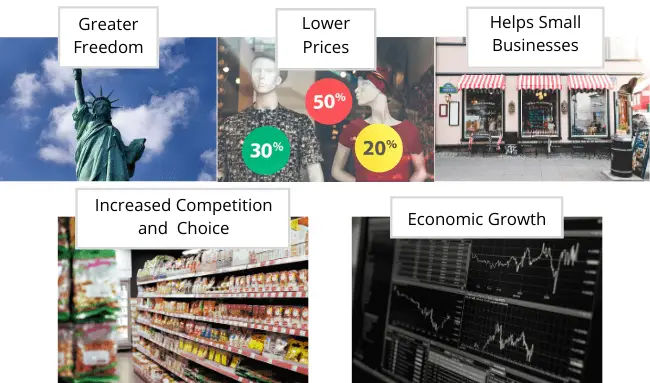Deregulation: Definition, Pros, Cons & Examples

What is Deregulation
Deregulation is where governments reduce the level of interference that they have in the marketplace. This involves looking at previous legislation and removing it from the law. In other words, what was previously legal requirements are no longer.
For example, it is a legal requirement in most nations to wear a seatbelt whilst driving. If caught, you may face a fine or other penalty, although most cases would result merely in a warning.
An example of deregulation would be if the government removed this law. So people are free to wear or not wear the seatbelt without the threat of punishment. This also extends into the business world. For instance, the removal of the minimum wage would be an example of deregulation. Essentially, deregulation is where any existing requirement that government places on business is removed.
Key Points
- Deregulation covers all aspects of government influence that include taxes and tariffs, laws and regulations, and government ownership.
- One of the main objectives of deregulation is to increase competition, with the end goal of creating a more efficient and innovative economy.
- An example of deregulation can be seen in the 1980s and 90s where the US deregulate the telecoms industry. AT&T previously had a monopoly, but following the actions taken by the US government, this was broken.
Advantages of Deregulation

1. Economic Growth
Some economists believe that deregulation can help stimulate economic growth. The theory is that by allowing firms to conduct business in the way they see fit, they are able to be as efficient as possible. There are no rules that mandate they can only open the factory for 2 hours a day, or use a specific material in production.
They no longer have to pay legal fees to determine whether they are complying, or the annual charges to pay. In turn, they have more capital to spend on investing in a new machine or more labour. This then has a ripple effect throughout the economy.
The money they save on regulation, the more labour they can afford to hire. As employment increases, there are more potential customers in the economy. That means more demand and potentially, more employment as businesses hire people to meet that demand.
2. Lower Prices for Consumers
In 2014, the National Association of Manufacturers (NAM) estimated that federal regulations in the US cost more than $2 trillion a year. Further research by the Commerce Department’s Bureau of Economic Analysis estimated regulations cost the US $1.9 trillion in 2017. That works out at roughly 10 to 12 percent of GDP.
These extra costs mean companies are paying more to meet specific regulatory requirements. Whether these are worthwhile or not is up for debate, but the additional cost of compliance is not. Business may have to hire lawyers, throw away good food, or build to a certain specification.
With the reduction in regulations, businesses can lower prices to attract customers. At the same time, regulations encourage competition as there are reduced barriers to entry. What happens as a result is a competitive environment that pushes prices down.
In markets such as airlines and telecoms, deregulation has attracted greater competition and lower prices for consumers. The evidence is in the fact that you can travel to another state or country for less than $50.
3. Increased Competition and Consumer Choice
As the government deregulates, it also reduces barriers to entry. New firms don’t have as many costs or considerations, so it is easier to enter the market. They may not need a permit for instance, or have to pay a certain wage or tax to do business.
What deregulation does is increase the incentives and ease by which competitors can enter the market. In turn, more businesses mean more consumer choice. So rather than having one toothpaste to choose from, there are three.
Examples can be seen within the airline industry, telecoms, as well as transport. For instance, Ireland significantly deregulated its taxi industry in 2000, which led to taxi numbers doubling within two years (Barrett 2010).
Not only have waiting times fallen, but also the number of people hailing for a taxi. In other words, greater availability and choice has attracted more customers.
4. Helps Small Businesses
Deregulation reduces barriers to entry as there are lower entry costs as well as lower on-going costs to meet regulatory requirements. In the US for example, the Motor Carrier Act of 1980 deregulated the trucking industry, resulting in a number of independent carriers entering the market.
The industry boomed with companies offering a greater variety of services as well as the choice to the consumer. Small firms found it easier to start a business and offer their services than ever before. And whilst competition increased, some small firms were able to grow and become leading players in the market. At the same time, there is space for small independents to offer a niche service. Something that was unimaginable prior to 1980.
5. Greater Freedom
Another advantage of deregulation can be seen from a philosophical point of view. Simply put, the argument is that the government has no business in telling people what they should or shouldn’t be doing. Instead, it should be up to the individual to decide.
Why should the consumer be prevented from buying a product or service because a government bureaucrat says so? Not only does regulation increase the price, but also the availability of choice, which, in turn, affects the individual’s freedom to choose.
By reducing regulation, we reduce the level of control that the government has in our lives, whether directly or indirectly. If we look at it another way, it is similar to the over-protective parent. One that won’t let their child do anything in fear they may hurt themselves. But in doing so, it harms their development. In the same way, the government is over-protective of the consumer, but rather than harming their development, it destroys their choice and makes them pay more.
Disadvantages of Deregulation

1. Lower Standards
Regulations are created with the aim of ensuring the free market does not fall below those standards. So when you buy a car, you can expect an airbag, seatbelt, and all other safety features. The argument is that without those regulations, businesses would seek to cut costs and remove such features from the vehicle.
This is known as ‘the race to the bottom’, whereby the competitive nature of the market encourages businesses to lower standards to attract unsuspecting customers. As regulations are relaxed, business no longer has to offer such a quality service. In turn, customers go for cheaper products or services which may pose a health and safety risk.
2. Private Monopoly
Some markets such as utilities lend themselves to a monopoly structure. Due to the nature of the service, it is more efficient for there to be only one provider of electricity and gas. That means energy lines etc. are best left to one firm to provide.
To have two or more grid suppliers, it would become both unprofitable and costly, meaning higher prices for consumers anyway. The argument, therefore, is to have centralised control over the resource in order to prevent monopolies price gouging consumers and making extraordinary profits.
Another solution lies in highly regulated private monopolies. That way, they are able to answer to any wrongdoings they may make in the market. At the same time, utility firms are often required to make necessary updates when requested by the government. Often, this is to ensure more rural areas have the same access as suburban ones.
3. Market Failures
When supply and demand are left in constant disequilibrium, we have what is known as a market failure. Equally, this occurs when there are negative or positive externalities. This includes the likes of pollution, or potentially an undersupply to the market, perhaps as a result of a monopoly.
When there is an excessive amount of pollution, it is often deemed necessary for the government to reduce this through regulation. This might be through a carbon tax or a quota. As a result, there are financial disincentives to pollute, which encourages firms to reduce the negative externalities they are producing.
Deregulation Examples
Airline Deregulation
In the US in 1978, the airline industry was heavily deregulated through the Airline Deregulation Act of 1978. It completely shifted power from the government to the market.
The Civil Aeronautics Board (CAB) had controlled the ability of firms to leave and enter the market, as well as pricing, mergers, and intercarrier arrangements. Under the CAB Sunset Act, this government entity was eventually phased out and abolished by 1985, leaving the industry to freely compete.
Europe joined sometime later with a number of deregulatory measures that were phased in through 1987 and 1997. Prior to 1997, nation-states within the EU were freely able to discriminate against international carriers. So only domestic carriers were able to serve the market.
Airlines were also majority-owned by the domestic government, but as part of deregulation, these were also relaxed. There were also rules regarding state aid, pricing, slot allocation, and air space which were also consequently deregulated.
The European form of deregulation was far more methodological and gradual, as the US had experienced a rapid and drastic change in a few years. As a result, the European market still faces greater regulation than its American counterparts, but has nonetheless opened the door to liberalisation of the industry.
There were initial fears that the quality of service would diminish, but that did not come to fruition. Instead, prices fell, passenger numbers rose, and the number of destinations and options also increased.
According to the EU’s own figures, passenger numbers rose by 558 million between 1993 and 2005. At the same time, a family trip from Milan to Paris in 1992 would have cost 16 times more than today – the minimum price for a ticket on this route has dropped from more than €400 to about €25 today.
Deregulation of Banks
The regulation of banks is both extensive and complex. In fact, there are few people who actually know how the whole system works, let alone the plethora of financial instruments that are on offer. With that said, it makes regulating such an industry that much more difficult.
Not only has the financial sector become complex, but also an integral part of society, which is why some banks have become ‘too big to fail’. And part of that has stemmed from the deregulatory efforts in the 1970s and 1980s.
Nations across the world started to deregulate in an effort to make their financial services more competitive. Regulations harmed innovation and growth within the industry. The US’ solution was the “Depository Institutions Deregulation and Monetary Control Act” in 1980 and “The Gramm-Leach-Bliley Act of 1999”. The acts allowed institutions to merge, set their own interest rates, and most importantly; use depositors money in risky investments.
In other words, the investment and retail sectors of banking were essentially merged into one.
What happened as a result was actually a consolidation within the industry as financial institutions became so competitive that they were put under greater financial pressures. As a result, those who succeeded consumed the smaller firms. In fact, the firms that took the greater risks tended to be the ones that survived.
This set the ground for the 2008 financial crisis as high risk equaled high reward. At the same time, it was the only way in which to compete. With that said, deregulation helped reduce interest rates for creditors and increased rates for depositors. The reason? Competitive pressures.
As regulations were lifted, a more competitive environment was created. That meant financial institutions had to lower rates to attract people to lend to, but also increase depository rates to encourage people to put money with them.
The Motor Carrier Act of 1980
In 1980, the US passed the Motor Carrier Act into law. It was part of a large initiative to deregulate the transport industry, but in this case, related specifically to trucking.
The Act reduced price controls, entry requirements, and allowed greater freedom to the regions and routes that truckers could take. In might seem odd now, but in previous years, trucking prices were set on a company by company basis and restricted interstate commerce. So one carrier was unable to transit goods between states.
The Motor Carrier Act changed in 1980. It modified the distinction between common carriers and contract carriers, which helped created greater competition between the groups.
The act allowed carriers to charge fees that differed from the regulated norm. It allowed carriers to travel and compete on a more geographical basis.
What resulted benefited almost all parties, with competition increasing, more firms in the market, cheaper carrier rates, and a more efficient market. However, one of the criticisms is said that lower prices have come at the expense of trucker’s wages.
FAQs
Deregulation is the process of removing government restrictions that make it more difficult to conduct business. These include reducing government regulations, rule, restrictions, or other market interventions such as subsidies or tariffs. The aim is to promote a healthy economy where there is competition with greater efficiency and innovation.
In the 1970s and 1980s, the banking industry underwent a drastic level of deregulation. Interest rate restrictions were lifted and investment and retail divisions were allowed to merge. Essentially, it created the groundwork the the 2008 financial crisis as banks used depositors money to fund risky investments. This came alongside an increase in value of deposit insurance from $40,000 to $100,000.
There are both positive and negative effects of deregulation. They are:
Positive Effects:
1. Economic Growth
2. Lower Prices for Consumers
3. Increased Competition and Consumer Choice
4. Helps Small Businesses
5. Greater Freedom
Negative Effects:
1. Lower Standards
2. Private Monopoly
3. Market Failures
It can be argued that deregulation is a good thing because it brings a number of benefits. The first of which is increased competition. As regulation creates barriers to entry, the relaxation of such restrictions makes it easier for competitors to enter the market. At the same time, it also allows for greater economic freedom and choice. For instance, you may no longer need a license to start your own business, allowing you to start it fairly easily. You may also find greater choice on the shelves as more businesses are able to enter to market and compete.
About Paul
Paul Boyce is an economics editor with over 10 years experience in the industry. Currently working as a consultant within the financial services sector, Paul is the CEO and chief editor of BoyceWire. He has written publications for FEE, the Mises Institute, and many others.

Further Reading
 Sunk Cost: What it is, Examples & Fallacy - A sunk cost is a payment that has been made but cannot now be recovered.
Sunk Cost: What it is, Examples & Fallacy - A sunk cost is a payment that has been made but cannot now be recovered.  Cluster Sampling - Cluster sampling is a sampling technique in which the population is divided into groups or clusters, and a subset of…
Cluster Sampling - Cluster sampling is a sampling technique in which the population is divided into groups or clusters, and a subset of…  Diseconomies of Scale: Definition, Types & Examples - It is an economic term that defines the trend for average costs to increase alongside output.
Diseconomies of Scale: Definition, Types & Examples - It is an economic term that defines the trend for average costs to increase alongside output. 